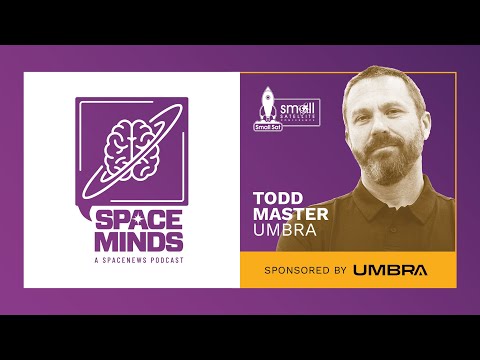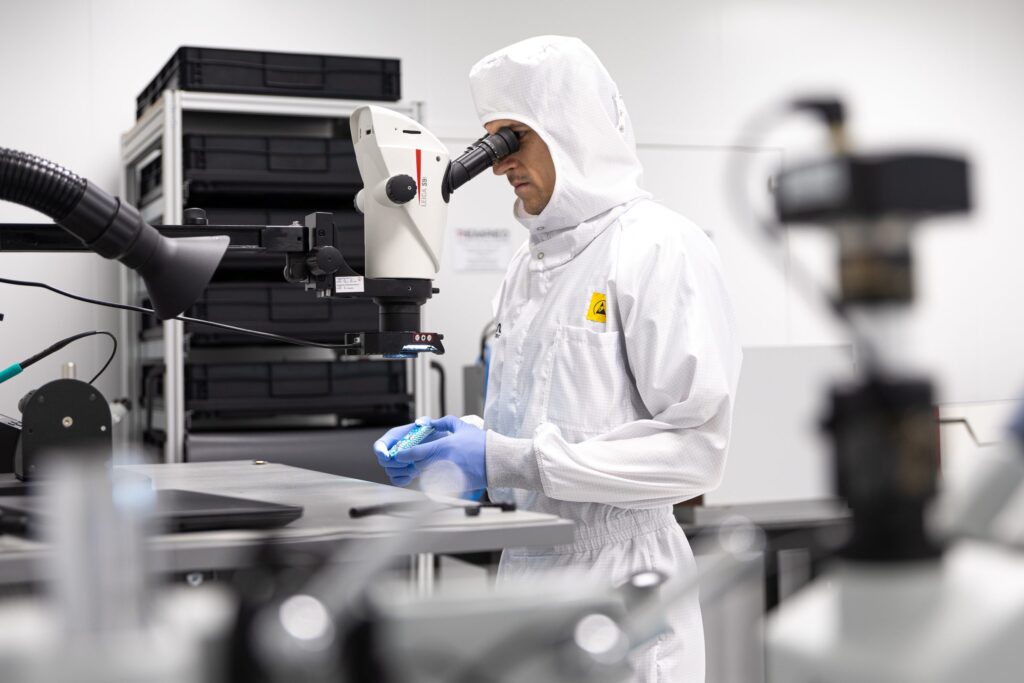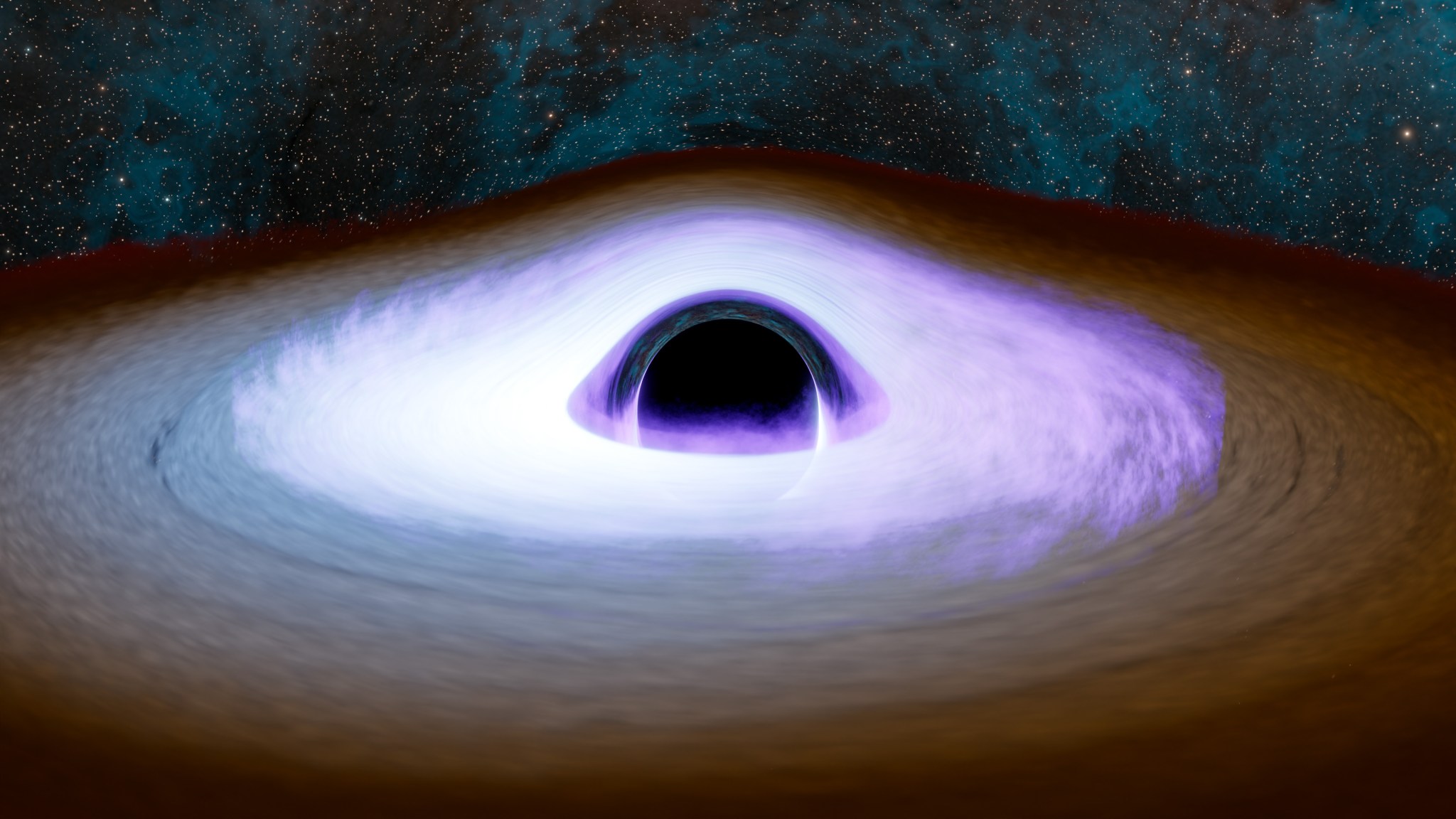Now Reading: Todd Master on Umbra’s evolution
-
01
Todd Master on Umbra’s evolution
Todd Master on Umbra’s evolution

This week SpaceNews is at the SmallSat Conference in Salt Lake City, Utah. In this episode of Space Minds, host Mike Gruss speaks with Todd Master, Chief Operating Officer of Umbra, about the evolving small satellite market, supply chain challenges, and the company’s expansion from SAR data services into satellite components.
Master discusses shifting investment trends in the space industry, the importance of building products around real customer needs, and how AI is reshaping operations. The conversation also explores how the definition of “SmallSat” is changing as launch access improves and technology cycles accelerate.
American-made. Umbra-rated. Delivered faster. Umbra is reshaping what’s possible in and through space — one component, satellite, and image at a time. We design, build, and operate the most capable radar constellation in the market, delivering unmatched access, clarity, and resilience for critical missions. Operating at every layer — from sensors to spacecraft to software — we accelerate innovation and operational advantage for those who can’t aIord to wait. Now, through our new Space Systems line, we oIer the same trusted, flight-proven hardware we use ourselves — engineered for power, precision,resilience, and control. Built to endure. Designed to deliver. Umbra puts control where it matters most.
Show notes and transcript
Click here for Notes and Transcript
Time Markers
00:00 – Episode introduction
01:09 – Welcome
01:38 – What are you looking for at SmallSat?
03:38 – A new business unit and thoughts on supply chain issues
07:34 – On tariffs
08:49 – Challenges
10:17 – On shifting gears
12:44 – Any surprises this week?
14:02 – The changing definition of a SmallSat
Transcript – Todd Master Conversation
Mike Gruss – Hi, I’m Mike Gruss from SpaceNews, and welcome to our Space Minds podcast from SmallSat. I’m joined today by Todd Master, who is the Chief Operating Officer at Umbra. Todd, thanks for being here.
Todd Master – My pleasure.
Mike Gruss – We have a team of reporters here in Salt Lake City, and we’re looking at a series of issues that aren’t going to be a surprise to any of our listeners, reliability versus cost, launch and launch alternatives, supply chain questions. Todd, let’s let’s start with you. When you are walking the floor, when you’re having meetings this week, what are some of the issues that that you’re listening for, or that you’re hearing from folks over and over again.
Todd Master – Yeah, I think the things that are interesting are, I mean, the thing, the thing, I think you’ll notice most of all in the show is that the proliferation of companies is huge, like, there’s, there’s just a ton of companies out there doing a lot of stuff. So, I mean, that’s, that’s encouraging for sort of the global space ecosystem, you know, and you know, a variety of different suppliers, vendors, all these sorts of things. The question is, just which of these are going to actually bring value, which are unique, which are differentiated? There’s a lot of people doing a lot of similar things. There’s only so many customers. What are they looking for? I think if that’s really kind of the It’s interesting. It’s an interesting part of the space ecosystem is, is, there’s a lot of excitement, but which of those things actually have real value? Is, is, and how can you draw a business case from it? How can you draw a business case? I think that that’s, that’s all there. You know, we’ve already been through our, definitely through our first wave of, sort of, like space private investment and a lot of interesting money, a lot of big money went into a lot of interesting ideas. Some of those companies have come and gone already. A lot of need technology. But is there a business case? Is there, is there a real, you know, actual utility in that, and not just that? Wow, this is really cool. We should do this because, right, that seems cool.
Mike Gruss – Yeah, I think there’s also a sense that there could be another wave of money coming.
Todd Master – I think we’re definitely in the midst of what I’d probably call the second wave. Maybe it’s the second wave. I think the first was probably in that 2021 then stack era, or maybe that was the third era, yeah, the first one, right? So I think there was kind of like a 2016 to 2018 maybe that culminated with the SPACs (Special Purpose Acquisition Company), and then we kind of went through a lull. And now I think you’re really seeing that coming back in a big way. So I think that that is probably one of the big questions is the sort of, you know, do you want to take, do you want to take a big investment from private, you know, from private capital, or big investment to sort of accelerate your business, or does it make more sense to, you know, continue to bootstrap and build your business case organically?
Mike Gruss – I brought up supply chain questions, Umbra made an announcement yesterday, Monday about a new business unit, and so talk a little bit about that in some of the supply chain questions that you’re hearing from, from folks who are here, and what that what, how you think that could close that gap?
Todd Master – Yeah, so I think a lot of people, people who are probably familiar with umbra, think of us as data as a service company. That’s really where we started the business. You know, the goal was to democratize SAR data. So synthetic aperture radar for those who are unfamiliar, right? So, day, night, all weather imaging works when you know, in darkness and clouds, which, if you think about it, which a lot of people don’t, right, half of the Earth is in darkness any given time. Two thirds of the Earth is covered by clouds. SAR imagery gives you imagery day night, all the time, but when we came into the market, it was relatively new as a commercial product. It certainly was not available in wide quantity. It was very expensive and was hard to get. And so we really made a goal to break down all those barriers and make it really accessible, transparent in our pricing, make it really just, you know, make it easy to use SAR data for our customers. And so in order to do that and make and do it in a cost effective and affordable manner and quickly, we had to make a lot of investments in our own space systems to get there.
So we build and operate our own constellation of, you know, world class our satellites, and a lot of that is underpinned by technology investments that we made on our side, and took several, you know, several years to kind of to get there. And as we look at, you know, what we have in the business and maturity that we have in that constellation, we saw an opportunity to not only sell the data, but then to go look at, how could we put platforms into our customers hands, and that was our mission, solutions business unit that we stood up last year. So customers would come to us and say, I like the data, but I might want my own system, or I want some variant of it, they can come to the mission Solutions team and work on, you know, a custom platform for their needs. And then the business line that we announced this week is our space our space systems business unit, which is now getting. You know, in the internals of the satellite. So the actual satellite components that sort of make our system go and work, and putting those into the marketplace. And the real reason we did that was in response to the challenges that we saw as a customer, right?
So we saw, you know, supply chain, we talked about, like the component supply chain, and sort of vendors that were available to us, they’re busy, like they’re really busy. The amount of investing going on from private capital and from proliferated constellations has really spiked. The demand for a lot of those systems, and the supply hasn’t really increased significantly. So a lot of those things that we were originally looking at buying from vendors we in sourced ourselves, just because there just wasn’t enough supply in the marketplace in a timely fashion, yeah, or qualified vendors, or qualified vendors. I mean, there were, yeah, there were a lot of interested, like, Hey, we’ve got a concept. And, you know, in a year or two, we might have this thing for you. And, you know, we will move on a pretty tight developmental cycle with a number so, so, yeah, we developed a lot of those things ourselves. And so we’re going out into the marketplace to basically offer another choice to customers there that, you know, we believe we’ll be able to deliver in a really timely fashion, but, but the unique part that we bring to the table is the benefit of flight experience and flight knowledge. So a lot of a lot of vendors in the ecosystem that, again, like you’ve got a really cool product, you’ve tested in the lab, you work through the bench, you kind of, you know how it works, you know, sitting in your lab and through acceptance testing. But when it comes to the actual like, how does it operate in space? Like, what’s your experience? Does it? Does it work the way you expect? When we’d ask other vendors that question, the answer we get was, like, I don’t really know, because we don’t operate it, right? You know, sometimes our customers tell us how it works, and a lot of times they don’t. So we, you know, it probably went well, but so we really, you know, we bring that experience to our customers that is unique to us.
Mike Gruss – I think there’s a lot of questions, not particularly this week, about tariffs, and how does, how does this ability to have components here in the US made? How does that help? Or what kind of conversation Have you had around that?
Todd Master – Yeah, I think, you know, it’s, it’s kind of a, it’s complicated, complicated issue, because it’s kind of a moving target. So it’s not exactly sure where that’s going to settle out. You know all, what I know for sure is space is a global marketplace. You know, there’s vendors all around the world, there’s customers all around the world. I think you’re always going to see some ebb and flow of, you know, where you need to see where customers prefer things from their own domestic source versus overseas. I think there’s a lot of variability that we’re seeing right now in Europe.
You’re seeing it now in Europe. So, you know, I’m, I think, I think having a domestic supply chain is a really important part of the business, especially for government systems. So that is a big part of why we want to be, you know, we’re a US company, US manufacturing. So when there are the requests from customers that say, this has to be a domestic supply chain, we’re able to meet that. But likewise, I think at the, you know, there are international customers who are going to continue to buy internationally. And I think you’ll, I think you’ll see that through, you know, the sort of ebbs and flows and changes in policy.
Mike Gruss – You talked a little bit about folks needing to find that business case that are on the floor. What’s something that, you know, when, when I walk the floor, when I’m talking to companies, there’s, there’s a lot of promise there. There’s a lot of there’s a lot of potential, but what’s, what do you see? Is, hey, where’s the gap? Where could, where could things get held up? Or where are some of the challenges that maybe folks aren’t, aren’t talking about as openly right now?
Todd Master – Yeah I think, I think there’s, I mean, the entrepreneurial spirit in the US is great, like that is, that is the economic engine of the United States. But building something that you haven’t really understood what your customers really want or what they need is, is Can, can come with a lot of risks. And I think you do see that a lot of somebody says, like, I built this thing and but they haven’t really engaged their customers and what they need. So I think having a deeper customer understanding of, if I go build this product, or I, you know, build this service, is that useful for you? When would you use it? How much? How much would you want to pay for it? Which is a big part of it that I think people don’t necessarily pay enough attention to. So they sort of say, well, I’m gonna have this product, and people are gonna want to buy it, but they haven’t really thought, can I do it in a profitable fashion? Can actually, like, have a sustainable company? You know, again, from from the space component standpoint, we had the benefit of being our own customer at the outset. So it’s we know what we need. And we know from, you know, sort of comparable companies that that they have very similar needs to our own.
Mike Gruss – When you’re working on the business, obviously, is there a topic or a subject that maybe you’ve changed your mind about the last year or two. I mean, there’s spaces. It’s still slow in some sense, yep, but it’s also moving much faster than it did. I think there are ideas that are that are catching on now that maybe wouldn’t have caught on, yeah, at the same pace a couple of years ago. So is there something that maybe you’ve. Changed your mind down or you’ve been like, Whoa, this is, this is something we need to watch.
Todd Master – I mean, it’s gonna sound a little bit it’s probably everyone will give the same answer, in some respect. But AI is really transformed things quite a lot, I think. And how so for you guys, for us, I think it was, you know, when, when the first set of, kind of like AI software tools was coming in the marketplace. It was sort of this interesting idea, but, but the immediate sort of reaction was, hey, this is a little bit of a threat. We need to it’s a threat to, like, our corporate IP. It’s a threat to some of the things we do. We don’t want to get spill our IP into a AI database, and now someone basically can find out what we’re doing. So, we had to really make sure that we were going to we’re going to be very cautious about our use of AI.
And I think over the last, you know, 18 months or so, if you’re not using AI as part of your workflow, you’re probably wasting a lot of time and energy and money. And so really, the smart use of AI and how you incorporate that into corporate infrastructure in a way that protects your own IP, but also, you know, drives down work products significantly in terms of, like, just rote stuff that employees would have to do, that would just take hours to do, that you can accomplish in minutes and AI tools. That’s huge. That’s really been huge. And, you know, things like optimizers, or even just getting to, like a first, a first, sort of, like basic set of concept, sorts of things that you’re just trying to, trying to string through. It’s like AI is almost like, I don’t know, I’ll use it like an intern who has, who knows some things pretty well, but I really need to check their math. I need to make sure they do stuff right. We were at, but it’s like a whole bunch of free interns.
Mike Gruss – It’s funny. I say that only because we were at GEOINT we had Robert Cardillo on the podcast, and he said it’s like interns who never take a lunch break or need to sleep. I thought that was pretty amusing.
Todd Master – I mean, those interns are getting really smart, like, really, really smart.
Mike Gruss – Has there been anything that surprised you this week, anything that you you didn’t expect to see, that you have or anything that has made you kind of say, Maybe I need to rethink this.
Todd Master – I haven’t seen any big surprises. I think it’s it’s interesting to see how companies at different spaces in the ecosystem, sort of like move in different directions, right? So I think probably, it’s probably it’s probably unexpected for some people to see a company who’s, you know, starting with data, move into components. But I likewise, see companies that have components are moving to systems. And I think you’re just seeing a lot of ebb and flow. And I think that is, why do you think that is, what do you think is driving that? I think it’s coming back to the earlier thing about, you know, making a business case close. I think it’s the sort of, if you have things available within your enterprise that customers are asking for, you should find a way to meet them.
And then that really is a big part of what we’re doing is right, if you’re going to offer data as a service, there’s a subset of customers who really want that, and then there’s other customers who say, like, I really just want, like, my, my ethos, or, you know, my, my funding source, or whatever, says I need to own this myself. You can continue to have an argument about why they should buy the data, or you can just do what your customers are really asking for and want to want to buy from you. So, so I think you’re seeing a lot of adaptation in the companies that have been successful in one part of it, and seeing, you know, how can they adapt their model to to meet their customers where they are.
Mike Gruss – Last question, this is kind of a fun one. We were talking yesterday about, when is a small set, not a small set. So, yeah, could be a size question. It could be something else. But how, how do you think of what is a SmallSat?
Todd Master – it’s interesting because, yeah, I mean the definition, yeah, the definition from a few years ago would have been a completely different definition from now. I think it really probably, when I think about it, it probably good, just, I don’t know that it’s defined as much as the size. I think it’s more about the there’s some class of spacecraft that we still think of as these sort of, you know, flagship programs, legacy programs, since, like nuclear command and control, or, you know, like James Webb, the sort of, like, really big, hey, this is going to take a decade to build, and it’s going to cost, you know, billions of dollars. I think we’re going to see fewer and fewer of those over time.
And the question is, is everything else a small set, right? Is everything else that’s not that, that you know, only took, like, a year or two to build? Is that going to be a small set, or is it something that you know, you can build in three months? Is that a small set? So, you know, it really started from the CubeSat thing, and then it was, you know, 100 kilograms. And so I don’t know that mass is really going to define it. I think it’s, I think it’s probably going to be about the, what’s your development cycle like? Does this need to be the mission that lasts, you know, for now and forever, or is this sort of a, you know, a rapid technology refresh platform? I think it’s small sets are getting a lot are getting a lot more defined by that, right? Is this sort of a, this is the right solution for a problem for a period of time, and we recognize for a couple years, right? And we recognize that that’s going to shift rapidly, and therefore, I don’t want to make a huge investment in any, you know, one satellite platform. This is a sort of like continuing problem.
And I think the evolution that you’re seeing is because launch has become a lot more accessible, and we can put more things up more quickly, and ride shares become the norm. I think that you are, I think that that really is what, what got us here. And I think it’s great, because I think it basically says, you know, we don’t have to define what the problem is going to be in three years and have a system that’s going to work through that. But I can, I can solve this year’s problem this year’s problem this year and next year’s problem next year, and go from there.
Mike Gruss – Yeah, great. Well, Todd, thanks so much for joining us. I’d like to thank our sponsor Umbra for the podcasts this week. All of our coverage from SmallSat is available at space news.com our August issue is on the newsstand, and we have show dailies available at our booth this week. Thanks so much for joining us.
About Space Minds
Space Minds is a new audio and video podcast from SpaceNews that focuses on the inspiring leaders, technologies and exciting opportunities in space.
The weekly podcast features compelling interviews with scientists, founders and experts who love to talk about space, covers the news that has enthusiasts daydreaming, and engages with listeners. Join David Ariosto, Mike Gruss and journalists from the SpaceNews team for new episodes every Thursday.
Watch a new episode every Thursday on SpaceNews.com and on our YouTube, Spotify and Apple channels.
Be the first to know when new episodes drop! Enter your email, and we’ll make sure you get exclusive access to each episode as soon as it goes live!
Space Minds Podcast
“*” indicates required fields
Note: By registering, you consent to receive communications from SpaceNews and our partners.
Stay Informed With the Latest & Most Important News
Previous Post
Next Post
-
 01From Polymerization-Enabled Folding and Assembly to Chemical Evolution: Key Processes for Emergence of Functional Polymers in the Origin of Life
01From Polymerization-Enabled Folding and Assembly to Chemical Evolution: Key Processes for Emergence of Functional Polymers in the Origin of Life -
 02Panasonic Leica Summilux DG 15mm f/1.7 ASPH review
02Panasonic Leica Summilux DG 15mm f/1.7 ASPH review -
 03How New NASA, India Earth Satellite NISAR Will See Earth
03How New NASA, India Earth Satellite NISAR Will See Earth -
 04And Thus Begins A New Year For Life On Earth
04And Thus Begins A New Year For Life On Earth -
 05Astronomy Activation Ambassadors: A New Era
05Astronomy Activation Ambassadors: A New Era -
06SpaceX launch surge helps set new global launch record in 2024
-
 07Two Black Holes Observed Circling Each Other for the First Time
07Two Black Holes Observed Circling Each Other for the First Time



















